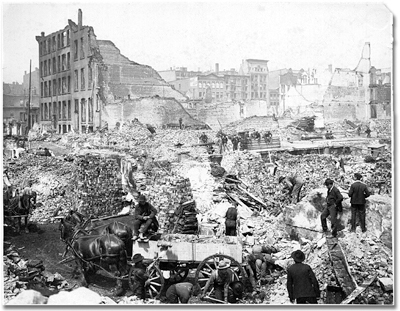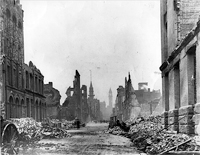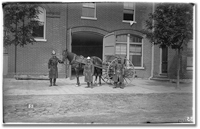
Features
Codes and standards
Hot topics
Making the grade
Fire insurance grades are one of the most influential aspects of fire protection and prevention in Canada but they are also one of the most misunderstood.
February 17, 2010
By Michael Currie
Fire insurance grades are one of the most influential aspects of fire protection and prevention in Canada but they are also one of the most misunderstood. To understand the role that fire insurance grades play in the development of fire protection and prevention programs, it is helpful to know some of the history of fire insurance.
The first known program of fire insurance was developed in London, England, subsequent to the Great Fire of London in 1666, in which an estimated 13,200 dwellings were lost in a catastrophic conflagration. In the aftermath of this fire, Dr. Nicholas Barbon, a physician and leading builder, proposed the idea of distributing the losses incurred during a fire among a larger group of people. Barbon offered insurance rates at 2.5 per cent of the value of brick buildings and five per cent for those made of wood. The program was quickly popularized and many competitive agencies formed.

|
| Front Street in Toronto after the great fire of April 19, 1904 Photo acourtesy City of Toronto Archives |
To reduce the extent of fire losses, these early fire insurance companies developed their own fire brigades, which would respond and fight fires at buildings that were insured by their sponsoring insurance companies. These brigades would practice publicly and, based on the skills they displayed, potential clients would select which insurance company to use.
In Canada and the U. S., fire insurance developed along similar historical paths with the first fire insurance company, the Philadelphia Contributorship, founded in 1752 with the assistance of Benjamin Franklin. Early insurance companies were not regulated with respect to reserving funds for claims and, as such, would sometimes fail during major fires. When this happened, policy holders would be paid just a fraction of their insured value. This considerably undermined the credibility of the insurance industry at large.
The overly competitive, capitalistic nature of the insurance industry also contributed to the failure of many insurance companies. Insurance companies tended to reduce premiums to undercut competitors. This practice was common and when major losses occurred, insurance companies that did not collect adequate premiums to cover losses would be bankrupted.
In an effort to lend some stability to the struggling industry, the Canadian government passed the Insurance Company Act in 1868. This act, to a limited degree, regulated insurance company financial practices.
The insurance companies themselves went through various stages of co-operation and competition that resulted in the formation of regional and provincial associations. These associations were used to encourage good business practices and to regulate insurance prices through tariffs based on the level of fire risk and fire protection as determined by the insurance companies. In 1883, these groups formed the larger and further reaching Canadian Fire Underwriters Association (CFUA).
 |
|
| Bay Street looking north from just north of Front Street, April 1904 Photo courtesy City of Toronto Archives (Photographer William James) |
The CFUA categorized Canadian municipalities into five classes (A through E) according to building construction and firefighting equipment. These classifications, or fire insurance grades, were used to allow all underwriters within the association to write insurance at similar rates based on the same underlying levels of municipal fire protection.
Fire insurance grades for Canadian communities have been published since the formation of the CFUA and although the system and organization have evolved, the grades are still published through the Fire Underwriters Survey.
Since the original schedule of fire insurance grades was developed, the system has become increasingly more sophisticated, with separate grades being produced for personal lines insurance and commercial lines insurance: personal lines insurance covers properties owned solely for personal use, such as detached dwellings and duplexes; commercial lines insurance covers all other types of buildings.
The grading system used by commercial lines insurers in Canada is the Public Fire Protection Classification (PFPC) system; the system used by personal lines insurers is the Dwelling Protection Grade (DPG) system. The DPG system is derived from the PFPC system with several simplifications and corollaries.
■ What are fire insurance grades?
Fire insurance grades are a measure of the capacity of the community to provide an effective level of response to structure fires (and conflagrations) that can be expected to occur based on the level of fire risk in the built environment. Numerous variables are considered in determining the fire insurance grades but the factors are generally broken down into the five broad categories: risk level; fire department; water supplies; fire safety control (including prevention and education); and emergency communications.
Fire insurance grades are determined by quantitatively measuring the level of fire risk (or fire potential) in the built environment, using this benchmark to determine the maximum credible effective response characteristics, then measuring all components of fire protection capacity against this benchmark.
■ How fire insurance grades are used by insurers
Insurance companies use fire insurance grades to determine their capacities for insurance. The capacities for insurance are generally defined as the maximum amount of risk a company can underwrite within a market or portion of a market based on the company’s financial condition.
Insurance companies also use fire insurance grades to determine appropriate property insurance rates, although each insurance company uses its own specific criteria and calculation method to determine appropriate premiums for insurance coverage. Other influential factors outside of fire insurance grades (such as loss experience in a specific geographic area or within a specific type of business such as industrial) are also considered.
Importantly, insurers rely on the fire insurance grade of a community to determine that community’s capability to respond effectively to structure fires. Personal lines insurers are interested only in the capacity to respond to detached dwellings (and duplexes) whereas commercial lines insurers are interested in the capacity to respond to fires in all types of buildings and the potential for multi-building conflagrations.
As each insurance company uses its own formula to set property insurance rates, it is not possible to specifically quantify the difference in property insurance rates from one fire insurance grade to the next, unless only a single insurance company is considered and all potential variables are taken to be the same. However, it can be said that as fire insurance grades improve, insurance companies consider the level of risk of loss to be lower, therefore increasing capacities and making the insurance market more competitive. This results in lower insurance rates for property owners.
■ Understanding the insurance lingo
Most insurers do not refer to fire insurance grades by their formal names and often refer to all fire insurance grades as “town grades” or “FUS grades”. When a community is considering improvements to fire protection or risk management that may result in improved fire insurance grades, it is important to understand that the benchmarks and impacts are different for personal lines insured properties and commercial lines insured properties.
 |
|
| The first fire brigade in Toronto’s Parkdale neighbourhood. Photo courtesy City of Toronto Archives |
Notably, the PFPC for commercial lines is intricate and complex while the DPG for personal lines is simplified and makes a number of key assumptions. One of the most important assumptions of the DPG system is that the level of fire risk inherent to detached dwellings (and duplexes) can be considered a constant when measuring adequacy of fire protection response. The level of risk is measured in terms of required fire flows and largely depends on the size and construction of the building considered.
Many insurance companies also simplify the fire insurance grades to a three-tier system, interpreting the fire insurance grades as being Table 1, Table 2, Table 3, or protected, semi-protected and unprotected respectively. These are derivations of the DPG and PFPC systems; each insurance company has its own specific criteria for interpreting the fire insurance grades but they are generally similar.
■ How do communities benefit?
Fire insurance grades allow Canadian communities to improve their fire protection levels incrementally in a measured fashion that can provide cost savings to property owners through reduced insurance premiums. Although these cost savings may not entirely offset the cost of fire protection, this is one of the few government service areas that does result in a return on investment.
The use of fire insurance grades in Canada results in:
- Incentivizes should this be incentives? for improvements to public fire protection, prevention and building controls;
- improved fire protection levels in communities;
- improved stability in the fire insurance market;
- improved standardization in fire protection levels;
- improved standardization in water supply development;
- improved standardization in fire risk management.
■ How much can property owners save?
Property owners can receive significant cost savings on insurance when the fire insurance grade in a community improves. For example, compare a detached dwelling property insured in a community with no fire protection recognized for fire insurance grading as to a property with identical characteristics in a community with a fire insurance grade that correlates to “protected”. The difference in fire insurance rates could be as much as 70 per cent per year. If the base cost of insurance is $2,000 a year, and when considered across hundreds of similar properties, the cost benefit of providing fire protection services that are recognized for fire insurance grading purposes is readily apparent.
Note that sometimes property insurance rates change even if the fire insurance grades remain the same. Insurers use the fire insurance grades as part of the determination of property insurance rates but fire is just one part of that determination (others include crime and flood, for example). Insurance companies are also directly affected by their own loss experience and the economic climate as they are generally invested in various markets.
■ What does this mean for my community?
It is important that local representatives of communities know the fire insurance grades and use this information in planning communities and developing fire protection service levels so that constituents can receive the greatest benefit possible when insuring their properties.
Michael Currie is the director of Fire Underwriters Survey for western Canada and can be reached at michael.currie@scm.ca or 1-800-665-5661.
Print this page